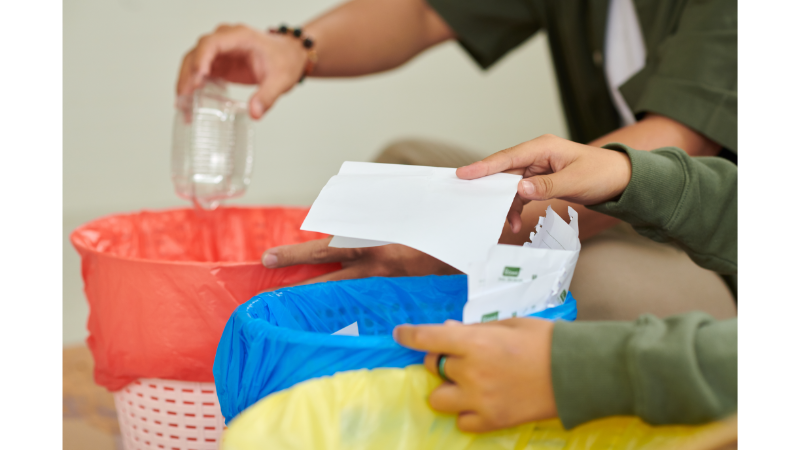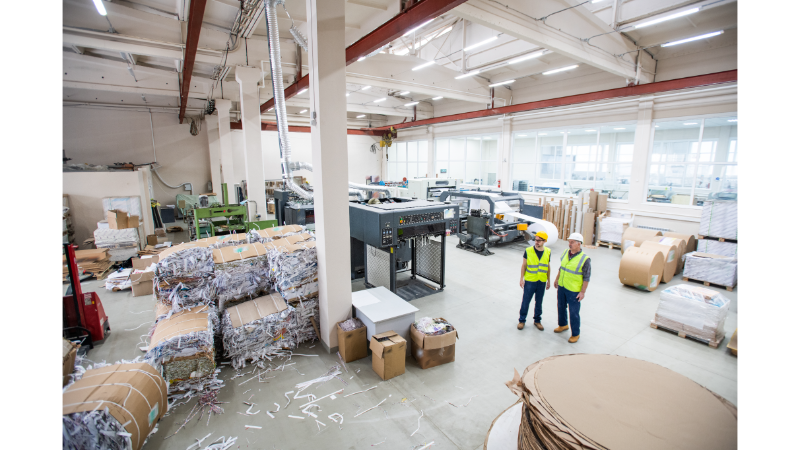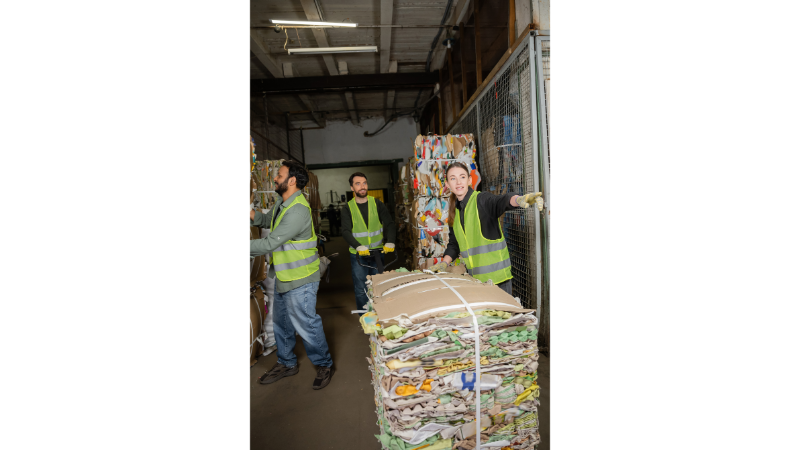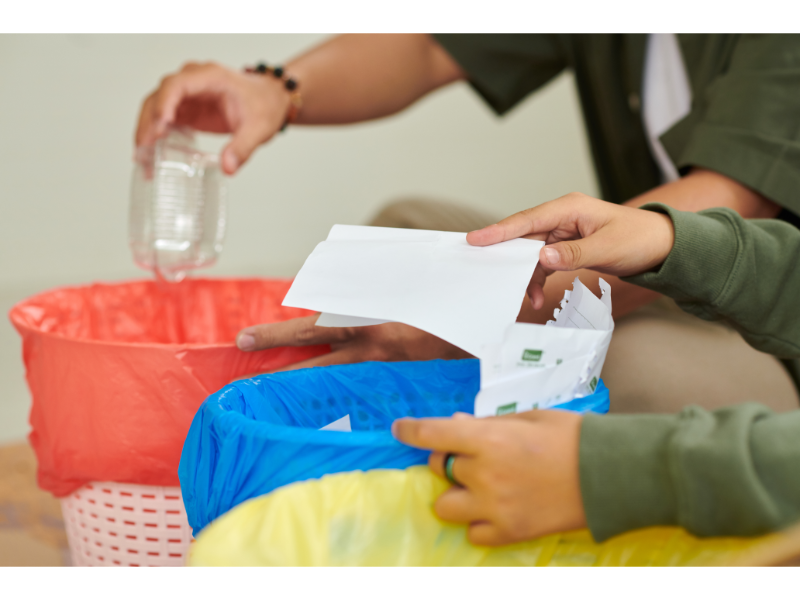Today, the rapid depletion of natural resources has made environmental awareness more important than ever. In sectors where industrial production and consumption have intensified, acting in line with sustainability principles is no longer a choice it is a necessity. At this point, paper, being one of the most common types of waste, plays a strategic role by helping reduce environmental impact and fulfilling corporate responsibility at the same time.
Paper recycling not only protects nature but also provides significant value to businesses through energy savings, cost efficiency, and legal compliance. Every ton of recycled paper prevents the cutting of dozens of trees and significantly reduces both water and energy consumption.
This article will explore in detail what paper recycling is, how the process works, which types of paper can be recycled, and what benefits this process brings to both the environment and businesses. Additionally, it will highlight the sustainable practices developed by BURKASAN, a company with 25 years of industry expertise, offering integrated waste management and recycling solutions to prestigious brands across Turkey.
Table of Contents
- What is Paper Recycling?
- Types of Recyclable Paper
- How Does the Paper Recycling Process Work?
- Benefits of Paper Recycling
- Paper Recycling Examples
- Bursa Paper Recycling
- Current Status of Paper Recycling in Turkey
- BURKASAN’s Role in Corporate Waste Management
- Frequently Asked Questions
- Conclusion
What is Paper Recycling?
Paper recycling is the process of collecting used, waste, or scrap paper and reprocessing it to be used as raw material in the production of new paper products. This process offers multifaceted contributions both environmentally and economically. Recycling significantly reduces the amount of wood needed for paper production. Thus, it supports the preservation of forests.
Reintroducing paper into the production cycle through recycling prevents waste from ending up in landfills. This brings substantial benefits in terms of waste management. Especially for institutions with high paper consumption such as offices, printing houses, educational institutions, and large scale manufacturing companies this process holds significant savings potential. Through recycling, businesses not only fulfill their environmental responsibilities. They also reduce raw material and waste management costs, achieving economic advantages.
Moreover, recycling practices provide a strategic opportunity for organizations to showcase their environmentally conscious and sustainability focused approaches to the public. In today’s world, where social awareness is rising, companies that demonstrate environmental responsibility not only strengthen their brand image. They also ensure compliance with legal regulations. In this respect, the paper recycling process is not merely a method of waste management. It is a comprehensive strategy where environmental responsibility is transformed into corporate benefit.

Types of Recyclable Paper
During the paper recycling process, many different types of paper can be reprocessed and reintegrated into the circular economy. Recyclable paper types play a major role, especially in household and corporate waste management. Below are some of the most commonly recycled types of paper:
- Office paper: Documents printed or unprinted and produced by printers are suitable for recycling. These papers are among the most frequently recycled materials in corporate offices.
- Newspapers and magazines: Newspapers, magazines, and similar publications that have been discarded after reading are highly recyclable. However, plastic coatings on them may need to be removed.
- Cardboard and corrugated packaging: Thick cardboard materials such as shipping boxes and product packaging can be reused in the recycling process. These materials are typically made of corrugated cardboard.
- Notebooks, books, and brochures: Printed materials that have reached the end of their useful life or have been damaged represent valuable recyclable resources. If the covers contain plastic, they should be separated beforehand.
- Used envelopes: Especially windowless envelopes have high recycling potential. Windowed envelopes should be stripped of their plastic parts.
- Kraft paper: Kraft paper used in shopping bags is durable and suitable for recycling. The prints on these bags typically do not interfere with the recycling process.
However, some types of paper are not suitable for recycling and should therefore be separated. Wet, greasy, or food contaminated papers cannot be processed in recycling facilities. These types of waste are usually classified as organic and are more appropriate for composting methods. Proper source separation of these materials enhances process efficiency. It also contributes significantly to reducing environmental impact.
How Does the Paper Recycling Process Work?
The paper recycling process consists of a systematic set of steps that contribute to environmental sustainability and reduce the use of natural resources. The main goal of this process is to make waste paper reusable and reintegrate it into the circular economy. Process generally includes the following key stages:
- Collection and Sorting: The first stage of the recycling process is collecting and properly sorting waste paper. Collection can be done from homes, workplaces, schools, or production facilities. The gathered paper is classified by type (white paper, newspapers, cardboard, etc.). This classification is crucial because it directly affects the quality of recycling and the characteristics of the final product.
- Shredding and Pulping: The sorted paper is broken down into small pieces using large machines. Shredding increases the surface area needed for the pulping process. These pieces are then mixed with water and specific chemical additives to separate the fibers.
- Cleaning and De-inking: The pulp is purified from foreign substances such as ink, staples, and adhesive residues. This stage is particularly important for removing ink stains from printed paper. The cleaning process is carried out using both mechanical and chemical methods. This ensures a more homogeneous and high-quality pulp.
- Drying and Reshaping: The purified pulp is passed through special drying cylinders to remove moisture. It is then flattened and compressed into paper sheets once again. At this stage, the thickness and size of the paper can be adjusted as desired.
- Reintroduction as a New Product: The dried and reshaped recycled papers are reused for various purposes. These include items such as notebooks, books, packaging boxes, paper cups, and paper bags. Eventually, these products reach the consumer once again. And the cycle begins anew.

Benefits of Paper Recycling
Recycling not only reduces environmental impact. It also provides numerous advantages on both economic and institutional levels. These multifaceted benefits encourage active participation in recycling processes by individuals and businesses alike. Below are detailed explanations of the main benefits of paper recycling:
- Conservation of Natural Resources: One of the greatest benefits of paper recycling is its direct contribution to forest preservation. According to research, recycling just one ton of paper prevents the cutting of approximately 17 mature trees. This is critically important for maintaining the balance of ecosystems.
- Energy and Water Savings: Producing new paper requires significant amounts of water and energy. However, thanks to the recycling process, the use of these resources can be greatly reduced. Producing new items from recycled paper requires about 60% less energy and up to 70% less water compared to original production. This helps lower energy costs. It also supports the conservation of natural resources.
- Reduction of Waste Volume: Recycling paper instead of sending it to landfills significantly reduces the volume of waste directed to disposal sites. This allows landfills to be used more efficiently and helps prevent environmental pollution. It also prevents waste from entering nature, easing long-term environmental burden.
- Cost Advantage: For institutions and organizations with high paper consumption, recycling offers a significant cost advantage. By optimizing waste management processes, both raw material needs and disposal expenses are reduced. This enables organizations to fulfill their environmental responsibilities while managing their budgets more effectively.
- Reduction of Carbon Footprint: Recycling activities reduce greenhouse gas emissions by requiring less energy in production processes. This directly contributes to the reduction of carbon footprints. Therefore, paper recycling is an effective step in the fight against climate change.
Paper Recycling Examples
Paper recycling produces tangible results in many areas of daily life. Recycled paper products are reprocessed across various industries, generating both economic and environmental benefits. Below are some examples of how paper recycling directly impacts our lives:
- Production of New Printing Paper from Used Office Paper: Printed or unprinted office papers used in institutions are collected and sorted as part of the recycling process. These papers are then cleaned and transformed into fresh pulp. The resulting clean pulp is reused to manufacture new printing paper. This allows the same functionality to be restored without the need to cut new trees. The recycled paper is reintroduced to the market for reuse.
- Turning Newspapers into Cardboard Boxes: Newspapers, widely used in everyday life, are collected after their useful life ends and processed through recycling. They are shredded and pulped. Then, they are transformed into thick and durable materials such as cardboard. This transformation is especially common in the packaging industry. Because cardboard boxes are highly effective for product protection.
- Reusing Cardboard Packaging in the Packaging Industry: Cardboard packaging is used in many areas, from grocery shopping to e-commerce shipments. These materials are recycled and reused as packaging products once again. Recycled cardboard is usually reprocessed into corrugated cardboard or durable shipping boxes. This contributes significantly to the reduction of packaging waste.
- Reprinting Notebooks and Books Used in Educational Institutions: Notebooks, books, and brochures are heavily used in schools, universities, and other educational institutions. Once these materials reach the end of their life cycle, they are recycled. This not only meets the needs of students. It also supports the environmental responsibility of educational institutions.
Bursa Paper Recycling
Bursa’s paper recycling efforts continue to improve as environmental awareness increases. Recycling centers and municipal collection systems safely recover paper waste from across the city. Local industrial facilities process tons of waste paper and contribute significantly to the economy. Schools, offices, and shopping malls use paper bins to promote public engagement in recycling. These efforts help conserve natural resources and reduce overall energy consumption. Bursa’s recycling programs also support the city’s long-term zero waste and sustainability goals.
Current Status of Paper Recycling in Turkey
In recent years, Türkiye has made significant progress in environmental policies and sustainability practices. Especially with the “Zero Waste” project, the contributions of public institutions, local governments, and the private sector in the field of recycling have become more visible. The expansion of municipal services for collecting paper waste, along with widespread awareness campaigns in schools and workplaces, has created positive momentum in recycling rates.
However, despite this progress, it is still evident that Türkiye has not fully realized its potential for paper recycling on a nationwide scale.
Particularly in areas with high paper consumption such as industrial facilities, shopping malls, office buildings, and educational institutions there can be shortcomings. These issues often occur in the regular collection and recovery of waste. This situation negatively affects both environmental sustainability and resource efficiency. To increase recycling rates, it is essential to invest more in infrastructure. Enforcement mechanisms must be strengthened. Public awareness should also be enhanced.
At this point, the role of expert companies operating in the recycling sector becomes critically important. BURKASAN provides services across Türkiye and has 25 years of industry experience. It stands out with its impactful practices in this area. The company offers integrated waste management solutions to businesses in various sectors. It ensures that paper waste is collected, sorted, and recovered in an environmentally responsible manner. Through the systems it implements, BURKASAN also helps ease the waste management burden of businesses.

BURKASAN’s Role in Corporate Waste Management
Achieving sustainability goals at the corporate level is possible not only through environmental awareness. It also requires an effective waste management system. At this point, companies specialized in recycling provide tailored solutions to businesses. These solutions help reduce environmental impact while also ensuring legal compliance.
Recycling should involve strategic practices. These practices must be customized according to the needs of businesses across different industries. Each organization has a unique operational field, waste profile, and regulatory requirements. BURKASAN operates with this awareness. It establishes integrated waste management systems tailored to each company. In doing so, businesses fulfill their environmental responsibilities. At the same time, they gain the opportunity to improve operational efficiency.
Frequently Asked Questions
Why is paper recycling important?
Because it protects natural resources and saves energy and water. It also significantly reduces waste, contributing to environmental protection.
Which types of paper cannot be recycled?
Wet, dirty, or greasy papers are not suitable for recycling. Carbon paper, photo-coated paper, and aluminum or plastic-laminated papers are also unsuitable.
How are recycled papers used?
They are reused in the production of new office paper, notebooks, cardboard boxes, packaging materials, and books.
How long does the paper recycling process take?
The process of collection, sorting, processing, and transforming into new products can take from a few days to several weeks.
How should paper be collected?
It should be kept clean, dry, and folded. It must not be mixed with plastic, metal, or organic waste.
Can household paper waste also be recycled?
Yes. Items like newspapers, magazines, paper bags, and clean packaging can be recycled from household waste.
How does recycling contribute to the economy?
It reduces the need for raw materials. It also creates jobs in the recycling sector.
Is secure disposal of paper waste possible?
Yes. Secure document destruction and recycling services are available, especially tailored for institutions.
How much energy is saved through paper recycling?
Compared to new paper production, approximately 60% less energy is used.
Does paper recycling reduce greenhouse gas emissions?
Yes. Emissions from production are reduced, which helps lower the overall carbon footprint.
Conclusion
Paper recycling is not merely an individual act aimed at protecting the environment. It is also a critical area of corporate responsibility that businesses are expected to fulfill. Today, the paper recycling process has gained importance for companies pursuing sustainability goals. This process has gone beyond offering only environmental benefits. Recycling allows businesses to reduce their carbon footprint. It helps minimize the use of natural resources. It also contributes to demonstrating their social awareness.
At the same time, this process offers a cost advantage. It helps reduce companies’ expenses related to raw materials and waste management. Moreover, it plays a vital role in ensuring compliance with legal regulations concerning waste management. Organizations that adopt a professional approach to recycling contribute to the environment. They also gain a competitive edge and strengthen their corporate image.
In conclusion, the paper recycling process enhances economic efficiency. It increases environmental awareness and stands out as a strategic step in corporate sustainability. Managing this process in a structured way is essential. With expert support, businesses can gain long-term benefits.
To read more of our articles and learn about sustainable recycling solutions, please visit our blog.

